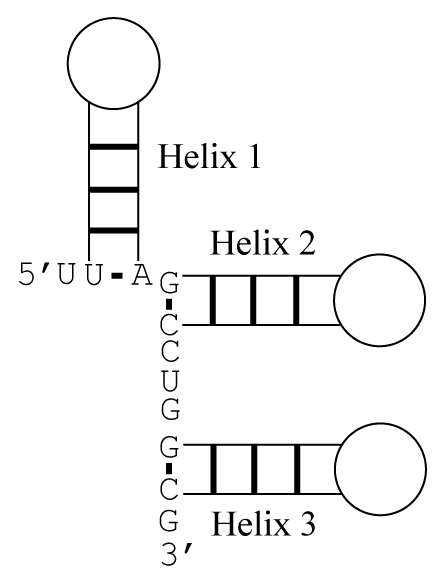20 Exterior Loops
20.1 Folding Free Energy Change
Exterior loops are stabilized by terminal mismatches, dangling ends, and coaxial stacks. The stacking is the optimal configuration of dangling ends, terminal mismatches, or coaxial stacks, noting that a nucleotide or helix end can participate in only one of these favorable interactions.
20.2 Folding Enthalpy Change
Similar to free energy change, exterior loop enthalpy changes are the sum of terminal mismatches, dangling ends, and coaxial stacks. The stacking is that of the lowest folding free energy change.
20.3 Example

Free Energy Change
Prediction of Stacking
The predicted stacking configuration is the one with lowest free energy change. There are two possible configurations.
Configuration 1:
Helix 1 with \(5'\) dangling U, Helix 2 with \(3'\) dangling C, and Helix 3 with a GG mismatch
ΔG°37 = ΔG°37(AU with \(5'\) dangling U) + ΔG°37(CG with \(3'\) dangling C) + ΔG°37(CG with GG mismatch)
ΔG°37 = –0.2 kcal/mol – 0.8 kcal/mol – 1.6 kcal/mol
ΔG°37 = –2.6 kcal/mol
Configuration 2:
Helix 1 in a flush coaxial stack with Helix 2 and Helix 3 with a GG mismatch
ΔG°37 = ΔG°37(coaxial stack of AU followed by GC) + ΔG°37(CG with GG mismatch)
ΔG°37 = –2.08 kcal/mol – 1.6 kcal/mol
ΔG°37 = –3.7 kcal/mol
Therefore, configuration 2, -3.7 kcal/mol, is the predicted free energy change.
